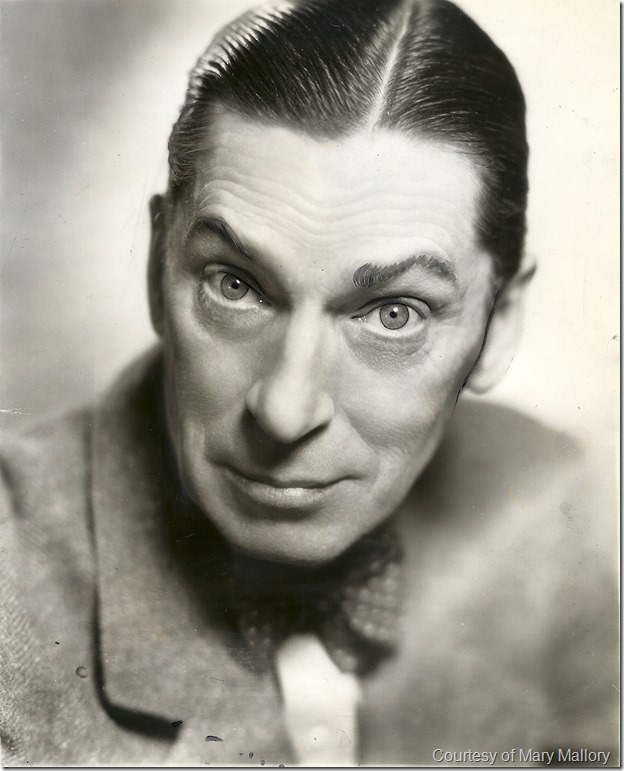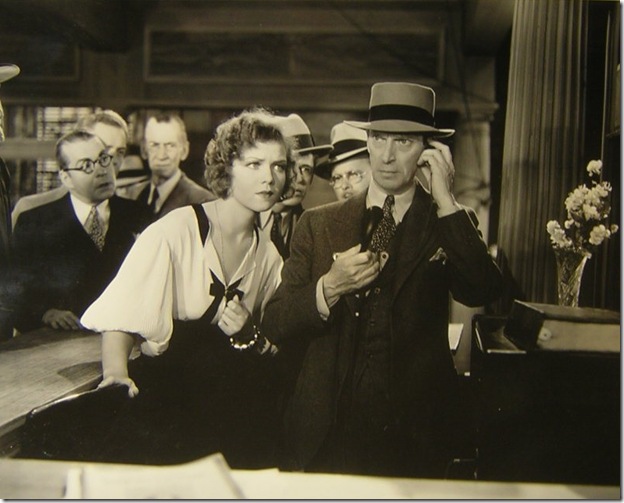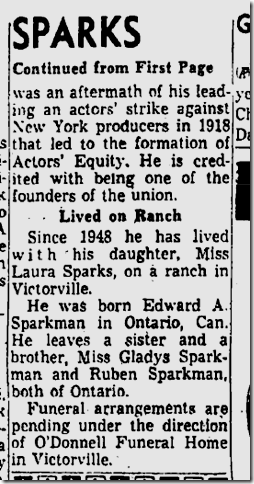
Ned Sparks in “George White’s 1935 Scandals.” Photo courtesy of Mary Mallory.
Throughout the history of film, many supporting players have functioned as the spine or safety chord upon which motion pictures have been built. Making the most of sometimes tiny bits, these men and women added a dash of pepper to proceedings, or helped define exactly how audiences should feel. Players like Franklin Pangborn, Charles Butterworth, Guy Kibbee and Ned Sparks always enlivened proceedings.
As the April 7, 1935, Los Angeles Times noted, stock players “are the less publicized heroes who appear in support of the stars, and, through the excellence of their “type” portrayals, often save pictures and frequently steal them…. They command good salaries, may only work a week on a picture, but are considered indispensable by casting directors.”
Ned Sparks acted as one of Hollywood’s standbys whenever an irascible, sourpuss was called for. An emaciated, pessimistic grouch, Sparks had a nasally, scratchy voice and made caustic quips that wowed audiences from the New York stage to America’s movie palaces.
Born Nov. 19, 1883, outside of Ontario, Canada, as Edward A. Sparkman, Sparks yearned for adventure, abandoning the ministry and traveling to Dawson City in the Yukon at the age of 17 to prospect for gold. Quickly abandoning the hard work and cold, he took advantage of his mellifluous tenor voice to sing in saloons, carnivals, tent shows, and the like, where he was billed as the “Singer of Sweet Southern Songs,” performing in a straw hat, bare feet and short pants.
Sparks tired of the barnstorming life after a short time and returned to Ontario, engaging in theological studies for two years before quitting to work a variety of odd jobs while landing supporting roles in touring stage shows coming through town. He set off for New York in 1907 at the age of 24, struggling to survive on bit parts and bartending work.

A photo of Ned Sparks in “Private Scandal” has been listed on EBay for $10.
His comedic timing and skills landed him roles on the New York stage in skits and playlets by 1911, where a review noted that he was “ever ready with quips and stalls.” He appeared opposite Douglas Fairbanks in one of Fairbanks’ last stage performances. Displaying his talent, Sparks also sang in musicals with people like Ernest Torrence, always drawing fine reviews, whatever the medium. Daily Variety and newspapers noted his talent for playing “grouch parts” in 1914, earning laughs with dry wit and deadpan expressions.
Off the stage, Sparks stood up for better working conditions. He deplored low wages, abuse and demeaning treatment of actors, joining in New York’s theatre strike in 1918 for better wages, becoming a leader in Actor’s Equity fight against producers. These actions led to his blacklisting for months.
Since he couldn’t find work on the stage, Sparks turned to moving pictures, landing parts in films with performers like Constance Talmadge, earning recognition for his “handsome bit of work.” As early as 1919, reviews noted Sparks stealing shows, or performing wonders with tiny parts. Even without his wonderful raspy voice, his piercing eyes, birdlike face and poker-faced responses gained huge laughs.

Sparks returned to the stage by 1920, appearing with such comic performers as Robert Woolsey, Leon Errol, Joe E. Brown, and Harry Langdon. In October 1920, Sparks, Brown, Langdon, and Frank Fay starred in “Jim Jam Jems,” a musical pastime proclaimed for its “exhilarating humor” and “enjoyable entertainment.” The show sold out four weeks in advance.
In 1923, Sparks moved West. He acted in shorts that fall, and performed with the Lambs’ Club at the Hollywood Bowl in the summer of 1924. Joining the Masquers’ Club, filmdom’s version of the Lambs’, Sparks performed in Revels with director Fred Niblo, and comedians Lloyd Hamilton and Roscoe Arbuckle.
Film Spectator greatly praised his work in a July 7, 1928, review. “I do not see Sparks on the screen very often, but when I do I always see an excellent performance. He is one of the funniest comedians we have. Some astute producer could take Sparks and make him a sensational success overnight. He is one of the greatest pantomimic artists in pictures, has a trained voice and a rich sense of comedy. In suitable stories he could be made one of the best box-office bets in the business.”
Sparks quickly earned praise in sound films as well, recognized for his dry comedy, wet blanket personality, and hangdog expression. The Hollywood Filmograph called him, “undeniably, the shining light of the cinema.” When Sparks signed a long-term contract with RKO in early 1930, it stipulated that he could sit in on story conferences and make suggestions regarding comedy situations and lines in both the Masquers Club two-reelers and features in which he appeared. Thanks to his squawky voice, Sparks really came into his own with the advent of sound.
Subtle on film, Sparks matched this talent off-screen as well. He secretly married Mercedes Caballero, sister of Charles Caballero, head of Fox’s Purchasing Department, on Oct. 10, 1930, keeping quiet for months about it. They seldom appeared in public, but Sparks was never a social butterfly away from work anyway.
The marriage soured by 1933, with Mercedes suing for cash, claiming that he was making $6,000 a month. Sparks countersued, claiming Mercedes’ dog bit him and friends, and the dog chased him out of bed. He claimed she thought more of the dog than him. In early December, Sparks was ordered to pay her $200 a month.
In May 1934, Sparks was granted a “mutual consent” divorce in Juarez, Mexico, with the papers signed three months earlier. Mercedes turned around and sued him in September for a real divorce, and this time went for the jugular. She claimed he wouldn’t let her announce their marriage for six months, so people thought they were living in sin, as well as threatening to abandon her, as she claimed he said he had been married twice before and “kicked out” his wives.
 Mercedes also purported that he was ill and only weighed 118 pounds when they wed, with Sparks stating he needed her then. She told a judge in July 1935 that Sparks had forgotten how to laugh off-screen. The couple divorced, and reached an agreement whereby Sparks paid her $10,000.
Mercedes also purported that he was ill and only weighed 118 pounds when they wed, with Sparks stating he needed her then. She told a judge in July 1935 that Sparks had forgotten how to laugh off-screen. The couple divorced, and reached an agreement whereby Sparks paid her $10,000.
Almost a year later, Mercedes filed a civil suit for more money, wanting half of the $150,000 she claimed Sparks had earned. The suit stated Sparks had committed fraud by not reporting his true earnings as well as threatening her and promising to testify she used drugs. Her motion was denied in 1936.
In 1940, Sparks announced that he was retiring from the screen, returning to Ontario to appear on a radio program. The show only lasted a few episodes as a travel program on CBS radio, before being revamped into a variety show.
Some fellow comedians probably welcomed it, as Jack Oakie called him the greatest scene stealer to The Los Angeles Times in 1941, noting, “Ned was deadly.” Sparks returned to Hollywood in 1942 to make a few films before pulling away again.
He appeared on the stage and in a few films in 1946-1947, before retiring to a ranch in Victor Valley to write his memoirs. Sparks did make a few guest appearances on television in 1950, as his agents at William Morris looked for a possible TV starring vehicle for him. He died April 3, 1957, of an intestinal blockage, supposedly survived by a daughter Laura, though there was never any earlier mention of her.


Wonderful. Ned Sparks is a longtime favorite grouch. Glad to see he sour as a dill pickle face here.
LikeLike
Whenever I see mention of these players, and I can hear Ned’s voice now, I think of Irving Bacon (director Lloyd Bacon’s brother) surely the most prolific of all supporting players. In Ned’s case, he had established a specific type, almost a specific character, who would bring a predictable set of facial and tonal expressions to the work. They were legion. You mentioned several. Eugene Pallette, Guinn ‘Big Boy’ Williams, Edgar Kennedy, Maxie Rosenbloom come to mind. But I know of no one sporting more IMdB credits nor who was more ubiquitous from about 1925 on than Irving Bacon. He seems to have been everywhere including such as It Happened One Night, Gone with the Wind, Grapes of Wrath (36 films in 1939 but only 27 in 1940!), all the way up to The Dick Van Dyke Show. Unlike the others, Bacon mastered the ability of nearly disappearing into the scenery. Nice piece, always enjoy your stuff. Thanks.
LikeLike
Mary, you mention that Ned Sparks was born “outside of Ontario, Canada. That would have him born in another province ’cause if he wasn’t born IN Ontario, then he’d have to have been born either in Quebec, to the east, or one of the western Provinces. Hmmmmmmmmmm?
LikeLike
Don… Online sources say he was born in Guelph, Ontario, Canada, which is about 92 kilometers west of Toronto.
LikeLike
Thanks for clearing this up. I used to live just south of Guelph. Know it well.
Regards. (Never looked him up on the IMDb. To be honest, I was never a fan.
LikeLike
Did anything ever come of Sparks’ efforts at writing a memoir?
LikeLike
I first saw him (as I did many of the classic Hollywood stars) in animated form in a few of the Warner Bros. cartoons from the 40’s. There wasn’t much change from the cartoon to the real person.
LikeLike
Ned Sparks was born a British Subject. He was born in Canada, but there is no such thing as a Canadian citizen prior to 1947.
LikeLike
Both Ned Sparks and his daughter Laura Edna Sparks (1908-1999) are buried in the Victor Valley Memorial Park in Victorville, CA.
LikeLike